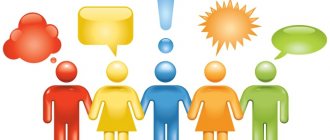Nonverbal is “body language” in a broad sense: the transmission of information through gestures, smells, taste, voice, visual signals. Nonverbal means of communication contribute to the creation of psychological contact between partners, enrich the meanings conveyed by words, and reflect the interpretation of the situation. Factors influencing the non-verbal side of communication are national characteristics, health status, professional etiquette, social status, and membership in certain age groups.
Means of nonverbal communication
Nonverbal communication what is it in psychology
Nonverbal communication is a type of communication without the use of words (through images, intonation, gestures, facial expressions). The tools for influencing a person are:
- sight;
- interpersonal space;
- optical-kinesthetic signals (facial expressions, appearance of the interlocutor, pantomime);
- peri-speech factors – vocal range, vocal qualities, timbre;
- extra-speech (laughter, speech rate, pauses).
For your information. Nonverbal methods of communication improve mutual understanding between people, allow you to predict the mood and attitude of the interlocutor towards the individual, and predict your own communication model.
The Origin of Nonverbal Communication
Perception - what is it in psychology
Nonverbal language has two types of origin: biological evolution and culture. Biologists have found that facial expressions when expressing emotions, most gestures and body movements in people are innate and serve as a signal for feedback. The biological nature of nonverbal communication is confirmed by elements not controlled subconsciously:
- paleness or redness;
- enlarged pupils;
- curvature of the lips;
- blinking.
Based on intentional and unintentional communication, there are 3 nonverbal means of communication:
- Behavioral factors. Caused by a physiological reaction: sweating from excitement, trembling in case of cold or fear.
- Unintentional means. Associated with people's habits (scratching temples, swinging legs, biting lips).
- Communication signals. Conveys brief information about an object, event, or state.
There are also universal signals known to everyone that are characteristic of a particular culture. Vivid examples are the style of behavior, dress code, and conventional signs of greeting and farewell.
Common “body signs”
Communication nonverbal communication
Personality development - what is it in psychology
Nonverbal means of communication are a system of signs that complement, enhance or replace speech:
- Akulesika. Messages are conveyed through glances. They depend on the frequency and duration, intensity of contact (closely or sliding). The gaze reduces psychological distance or is perceived as a threat.
- Kinesics. Combines looks, facial expressions, postures, gestures, movements of sociocultural and physiological origin.
- Tactile behavior. The communication method is based on touch (ritual, love, professional, friendly) to strengthen or weaken communication processes.
- Chronemics. Use of time in nonverbal communication. For example, in the United States being late is considered disrespectful, but in Latin America this situation is common.
- Proxemics. Relationships are built taking into account distances and territorial locations.
- Sensory. The attitude towards an individual is based on perception by the senses (sensation of sound, taste, warmth of the interlocutor).
- Paraverbal communication is determined by vocal timbre, rhythm, and intonation when transmitting information.
Important! Specialists in nonverbal psychology combine the listed types of communication into various forms of information transmission: sign-symbolic, optical-kinetic, tactical and phonation (sound).
The role and importance of communication means for humans
Communication itself is one of the main attributes of human life. And all means are important: both verbal and non-verbal communication. Each means expresses its “share” of information, and the ability to read different “codes” helps to assess the situation as a whole.
Non-verbal communication, in particular, becomes necessary when verbal mutual understanding is impossible. For example, if the interlocutors speak different languages or one of them is deaf and dumb. Various sign languages have been developed for such purposes. Interestingly, in New Zealand the local sign language has the status of an official language; In this language, the English-speaking white population communicates with the Maori, an indigenous people whose representatives do not always agree to learn English.
As for ordinary situations, the importance of the non-verbal “part” of a conversation was shown by the Austrian writer Alan Pease; he states that only seven percent of information we receive from the verbal component of communication, and the rest we perceive through non-verbal signals. Researchers have also noticed that in recent years the role of non-verbal communication has increased significantly. One of the reasons for this may be caution: the interlocutor may well lie, hide information, and his true intentions can only be established by “reading” gestures and facial expressions. Increased tolerance also prevents people from using emotionally charged expressions in speech, and then nonverbal signals come to the rescue.
Detecting lies is one of the most important skills. The effect is based on the fact that most people do not control their emotions, so they may not correspond to the words spoken. Words can deceive, but their gestural “accompaniment” is not capable of this. Unless, of course, the interlocutor has learned to control himself and use facial expressions and gestures to further confuse the one with whom he is talking.
Learning to recognize non-speech information can take quite a long time. After all, there are not only well-known and understandable signals that are reflected even in phraseology (“head drooping,” “standing with mouth open,” etc.), but also rather subtle and non-obvious signs.
American writer Julius Fast once described an interesting incident. At one school there was a girl from Puerto Rico, whom the principal once found among a group of her peers smoking. All of these girls were arrogant and undisciplined, except for this Puerto Rican girl. Nevertheless, the director decided to punish her because he caught her in what he considered “suspicious behavior”: when talking, she diligently averted her eyes. The girl was saved by a local Spanish teacher, who explained to the director that in Puerto Rico, well-mannered girls never look adults in the eyes, which is a sign of respect.
It is obvious that the language of gestures, facial expressions, and intonations has a more ancient origin than “ordinary human” language. Indeed, articulate speech is a rather complex phenomenon, requiring not only a developed speech apparatus, but also the necessary level of abstract thinking. But nonverbal communication is widely available to animals. From them, apparently, we got most of the extra-speech signals.
In animals, postures, intonations of vocal cries, facial expressions express relations of superiority and submission, the choice of a partner for mating, friendship or enmity, and other information. Often, exchanging threatening postures and shouting can help avoid a fight, which may be disadvantageous to both parties. Primates, of course, have the richest system of gestures, postures and facial expressions, but many other animals also have their own sets of signals.
Non-verbal communication even allows us to contact our smaller brothers. The position of a cat or dog's tail can tell a lot about the animal's mood at the moment. Staring is an ominous signal for dogs and cats, especially if you look directly into their eyes.
Types of nonverbal communication
Gestures
Placebo effect - what is it in psychology
Nonverbal gestures include pronounced movements of the head, hands, fingers, accompanying statements and thoughts. If people need to pay attention to objects, they will need the help of pointing gestures. Emphasizing gestures reinforce statements. A demonstrative movement of the brush explains the state of affairs. Touching a partner helps to establish social contact or receive a sign of attention, weakening the significance of information. Gestures are performed in voluntary and involuntary forms.
Pose
Postures must follow the rules of etiquette. Open poses of a sitting girl in Europe and America have neutral meanings; in Japan they are considered immoral. The squatting position of adults in most countries has an indecent definition; in South America and Africa, many peoples rest in a similar form. Using a chair is assessed as aggression.
Poses of strength and weakness
Postures during a public address or business conversation should express openness: arms unclasped, legs uncrossed, back straight. If you lean forward a little, your posture will be perceived as interest in an understandable topic. Slouching communicates uncertainty, while wide-set legs and arms indicate dominance. Tapping with a hand or foot is a manifestation of boredom, lack of time, impatience. The interlocutor took a closed posture - this may mean that the person does not believe or does not perceive the information well. The legs are turned towards the exit, the person wants to leave. The head is tilted forward, the interlocutor listens carefully and analyzes.
Facial expressions
Facial expressions are commonly called expressive movements of the facial muscles in order to express certain feelings of an individual. The types of facial expressions correspond to the functions of the psyche: mental acts are expressed by the muscles around the eyes, the perioral muscles are associated with acts of will. Feelings are emphasized by the general muscles of the face, changing in conscious and involuntary forms.
Various forms of facial complexes are possible:
- Amymia is the absence of visible facial changes.
- Tension can be indicated by a tight closure of the mouth and a petrified state of the upper part of the face.
- Interest can be easily recognized by a slight raising or lowering of the eyebrows, a slight widening and narrowing of the eyelids. The field of view increases, the focusing of the eyes becomes sharper.
- A smile can refer to calming or distracting from aggressive behavior, and is used when greeting.
Facial expressions convey basic emotions (joy, sadness, anger, surprise, disgust), provided by innate neural programs, as well as false information.
Facial display of emotions
Distance
The norms of approach between two people are defined in science by four intervals:
- Intimate. A length of 0...45 cm is considered optimal for communication between close people.
- Personal. A gap of 45...120 cm is maintained when communicating with familiar people.
- Social. A distance of 120...400 cm is recommended for official negotiations and conversations with strangers.
- Public. At a distance of 400...750 cm, it is not considered rude to exchange a couple of phrases; this interval is observed when speaking in front of an audience.
According to the teachings of social science, the rules vary for people of different ages, gender, and social status. For example, children and old people stay closer to their interlocutor, compared to teenagers. Men occupy distant positions, unlike women. A calm person gets as close as possible, an unbalanced person stays further. People address interlocutors of higher status at a great distance. Nationality also plays a role. Asians interact over shorter periods than Europeans, city dwellers are closer to settlers in sparsely populated areas.
Intonation
Prosody (voice tone, timbre, sound intensity, pauses) regulates the flow of speech, complements or replaces statements, and expresses the emotional state. It is important to be able to hear the intonation structure of speech, evaluate the strength and tone of voice, speed of speech, expressing the feelings and thoughts of the interlocutor:
- excitement is manifested by a low tone of voice, fast, abrupt speech;
- enthusiasm is demonstrated by a loud voice and clear, confident speech;
- fatigue can be easily determined by a low tone of voice, weakening of intonation towards the end of a sentence;
- signs of arrogance can be slow speech, even monotonous intonation;
- uncertainty is felt by interlocutors who make mistakes in words, frequent pauses, and nervous coughing.
The voice contains a lot of information about the owner. Experienced voice specialists are able to study the age, place of residence, character and temperament of the owner. People who have the ability to dramatically change the pitch of their voice are more sociable, more confident and pleasant than monotone or uncertain interlocutors.
Clothes speak about a person
Cloth
When forming an image, a person tries on a role in society and internal positions. The key characteristic is not fashion, but the style direction and color scheme. Extroverts rely on bright, rich colors. Introverts choose dark tones, nondescript, halftones, black, bed, beige, gray. Bright and large jewelry can also be a means of demonstrating a person’s egocentrism and high status (or the individual himself desires it).
Eye contact
Eyes can also be used to express a wide range of human feelings and emotions. For example, eye contact can mean the beginning of a conversation, during a conversation it is a sign of attention, support or, conversely, termination of communication, it can also indicate the end of a remark or a conversation as a whole. In conversation, people often look into each other's eyes because the eyes are what most draw our attention to the speaker's face. They not only occupy a central place in the field of vision, but are also able to most accurately convey the true emotional state of a person. It is not for nothing that many consider the eyes to be the mirror of the soul, and their movements indicate the course of thoughts. Conventionally, the following types of appearance can be distinguished: business, secular, everyday, friendly, intimate and final.
A business look is usually directed at a conventional triangle formed by the interlocutor’s eyes and mouth. Sometimes it is directed to the center of the forehead and does not go below the eyes. It is used in conversation and negotiation and indicates the formality or formality of the relationship between communicating partners, who usually sit opposite each other. Social gaze covers the area of the face, neck and chest and is used when communicating in small groups of up to 20 people. Most often it can be found at various meetings, presentations, press conferences and business meetings. The social look is the same as the business look, but it is much softer and more attractive in appearance. It is used for small talk, guests or receptions. A friendly look is characterized by the fact that the eyes of the person to whom it belongs move within the triangle formed by the eyes of the interlocutor and the center of his chest. Usually it is typical for people who are in an informal relationship with a partner, and indicates the presence of a certain spiritual closeness to the person to whom it is addressed. An intimate gaze usually does not have a constant direction; it moves and slides vertically. Most often it is observed in informal interpersonal relationships between people of the opposite sex. In one-on-one conversations, in situations where one of the interlocutors wants to show the other that he wants to quickly end the conversation for negative reasons, the so-called closing gaze is used. Usually it is directed to the center of the partner's forehead and does not move anywhere.
Features of the interlocutor's gaze are the direction of gaze, frequency of blinking, pupil size, eyelid position, visibility of the corner of the eye, duration of concentration, shine and opening. Depending on the direction, there are the following types of gaze: straight, past, through a partner, sideways, up, down, in breadth and upward. Direct gaze is an indicator of confidence and respect for a partner, as well as a desire to initiate or continue contact. Looking past your partner shows indifference to him and the egocentrism of the one who gives it. People who show clear disrespect for another person, and sometimes an aggressive attitude towards him, see right through their partner. A side glance is used when there is distrust, suspicion and skepticism towards the speaker. Looking up radiates a feeling of arrogance, superiority, or contempt for a particular person or event. The downward gaze is used in two cases - in a state of extreme anger, bordering on aggression ("frowning"), and in a state of humility and submission, expressed by bending the upper body and head forward. Looking into the distance during a conversation indicates the emergence of doubts, hesitations and mistrust on the part of the interlocutor. Such a look can also be a sign of a thoughtful attitude towards something important. This condition may correspond to looking up with the eyes slightly raised towards the forehead. When a person is busy raising a thought to express it, he usually looks away when the thought is ready for expression and looks at the interlocutor. It is noticeable that the speaker looks at the interlocutor less than the listener. The first one does this only to make sure that the partner's attention and interest is maintained, and the second one does this to provide feedback in the conversation.
There is an opinion that the interlocutor’s gaze during a conversation should meet the partner’s eyes for approximately 60-70% of the total duration of the conversation. It is known that sociable and sociable people look at their interlocutor more carefully and longer than withdrawn and closed people. We spend more time looking at those we admire and with whom we have close relationships. It has also been found that women look at their interlocutor longer than men; and if the interlocutor is a woman, then the duration of eye contact is longer. By the way, the latter is also typical for male speaking couples. Only men look longer at those they like, and women look longer at those they like. When communicating with businessmen, you should consider whether the topic under discussion is pleasant or unpleasant for one of the parties. Accordingly, a gaze directed at a person that is unpleasant or incomprehensible may be perceived as annoying. It should be remembered that most of us avoid eye contact during arguments and conflicts. This is especially true for women. It has been observed that the closer the interlocutors are during a conversation, the less they look at each other, and vice versa.
Features of nonverbal communication
Nonverbal communication is a situational reflection of people’s personal characteristics: mood, emotional background, attitude towards others and the topic. This communication is involuntary and spontaneous, it is difficult to divide it into individual elements (postures, facial expressions, olfactonics), this is the key feature of nonverbalism. Gestures, intonation, gaze are difficult to study or edit; it will take years and decades. But even trained people can be caught lying when one part of communication does not match another. Sign language is trusted more; it is perceived at the level of intuition.
Open posture in negotiations
Nonverbalism is an important element of communication, carrying 60-80% of information with the body, only 20-40% of communication is realized in words. It is worth closing your eyes and hiding your hands if you need to hide insincerity - this was the conclusion of one observant English court official.
Microexpressions and involuntary nonverbal cues
Involuntary nonverbal behavior is those contractions of the muscles of the body and face that a person is unable to control.
Consciously telling a lie, trying to hide feelings, a person is nevertheless unable to control the so-called micro-expressions flashing on the face. These are tools of non-verbal behavior that help a specialist psychologist or simply a very observant interlocutor to recognize deception, an attempt to hide information or emotions, since it is impossible to consciously keep muscles from contracting such muscles.
Representatives of certain professions, for which the ability to recognize deception is very important, are taught this ability, or they look for people who are initially predisposed to reading microexpressions. Thus, the ability to detect a lie is extremely important for customs officials, security services, and investigators.









